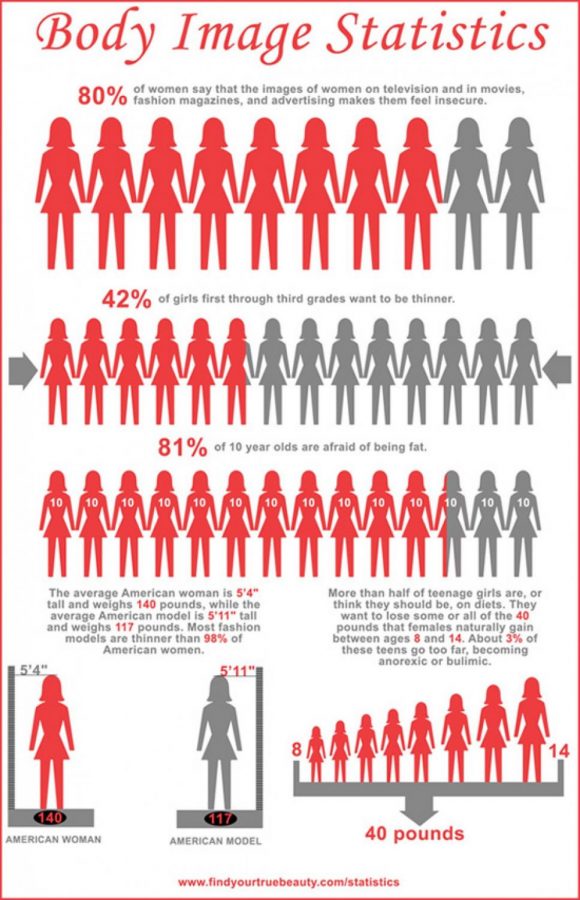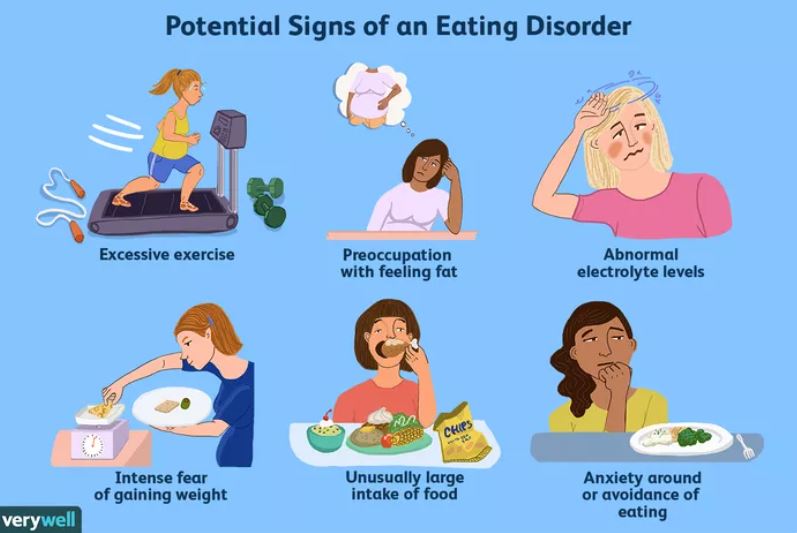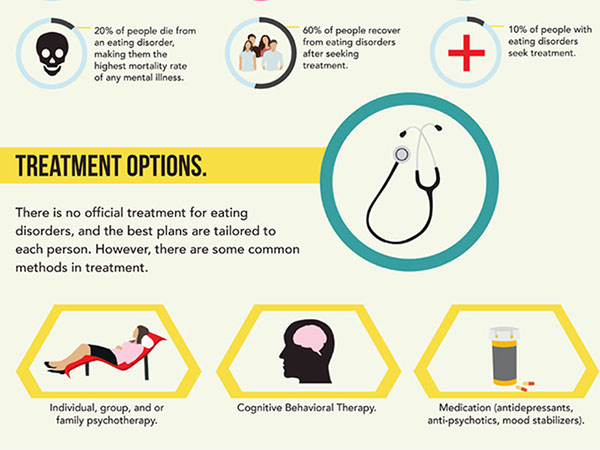The Weight of the World
Eating disorders target all ages, but young women are particularly at risk, especially in a society that prizes thinness.
photo courtesy of Westend61 / Getty Images
People who suffer from eating disorders often feel trapped inside their constant desire to obtain a certain body weight and shape.
Eating disorders involve a range of psychological conditions that can cause the development of unhealthy eating habits. This mental health condition often starts with an obsession with food, appearance, weight, or body shape. It’s important to be aware of the causes and symptoms, because severe cases can result in death.
People of any age can be affected by eating disorders, but they’re more common in adolescents and young women. Up to 13% of youth may experience at least one kind of eating disorder before they are 20 years old. In the U.S. alone, an estimated 20 million women and 10 million men have had an eating disorder at some time in their lives.
There are a variety of symptoms, such as severe restriction of food, food binges, and purging, which compensates for calorie intake, such as vomiting, over-exercising, laxatives, or diuretics.

Eating disorders can be caused by several different factors. A study on twins separated at birth and adopted by different families shows that genetics play a role. The study showed that despite the twins’ separation, they were both still likely to develop an eating disorder. If one twin developed one, the other twin would have a 50% likelihood of developing one as well.
Personality traits are also linked to the development of eating disorders. Neuroticism, perfectionism, and impulsivity are all risk factors for eating disorders.
Arguably the biggest risk factor for developing an eating disorder is society itself. Perceived pressures can have a large effect on young women especially, which can lead to an unhealthy relationship with food. Social media and the prevalence of Photoshop can cause insecurities and the idea that a certain body type is the desired beauty standard. Exposure to these ideals in the media can have a negative effect on mental health.
Cultural preferences can make people believe that they must look a certain way in order to be socially accepted. For example, Western culture tends to value thinness, while other cultures may not find body type to be so important. Certain eating disorders appear to be almost nonexistent in cultures that haven’t been exposed to these ideas and standards.
Additionally, favorite activities and sports have an impact on eating habits. For example, ballet is known for traditionally valuing leanness. Some sports, such as skating, may also involve subjective scoring based on body shape, causing participants to obsess over their appearance.
Not only can eating disorders be caused by a person’s upbringing, but they can also be caused by neurological issues. Differences in brain structure and biology can play a role. The brain’s messengers involving dopamine and serotonin may be factors in developing unhealthy eating habits. Psychological and emotional issues are closely linked with eating disorders. Other mental health conditions, such as depression and anxiety, can lead to disordered eating.
There are three main types of eating disorders: anorexia, bulimia, and binge-eating. The best-known type is anorexia nervosa, which is characterized by constantly monitoring one’s weight. It generally develops during adolescence, affecting more women than men.
People who are anorexic tend to view themselves as overweight, even if they’re dangerously underweight. They may avoid eating certain kinds of food, restrict their calorie intake, and have an intense fear of gaining weight. Perceived pressure to have a certain body weight or shape can heavily influence self-esteem, creating a distorted body image. People who suffer from anorexia often have obsessive-compulsive symptoms and experience difficulty eating in public, which causes them to want to control their environment. They are constantly preoccupied with thoughts of food, sometimes obsessing over recipes, cooking, baking, etc.
Anorexia can be categorized into two types: the restricting type and the binge-eating/purging type. The restricting type is recognized by the constant desire to lose weight solely through dieting, fasting, or excessive exercise. The binge eating/purging type involves either binging on large amounts of food or eating very little. After eating, someone with this type of anorexia may purge by vomiting, taking laxatives or diuretics, or exercising excessively.
Its effects on the body include thinning of their bones, infertility, brittle hair and nails, the growth of a layer of fine hair all over their body, and hair loss. In severe cases, anorexia can result in heart, brain, or multi-organ failure or death.
Bulimia is another common type of eating disorder, characterized by using purging techniques to make up for the amount of food consumed. Like anorexia, it tends to develop during young adulthood and is more prevalent among women. Bulimia has similar symptoms to the binge-eating/purging type of anorexia. However, rather than becoming severely underweight, people with bulimia usually maintain a relatively normal weight.
People with bulimia often feel that they cannot control how much they are eating, which can leave them feeling guilty and regretful afterward. They typically consume enough food to make them painfully full, causing them to purge to relieve their physical and mental discomfort.
Some symptoms of bulimia include recurrent episodes of binge eating, a feeling of lack of control when eating, inappropriate purging behaviors to prevent weight gain, self-esteem overly influenced by body shape and weight, and an overwhelming fear of gaining weight.

There are a plethora of side effects that bulimic people are likely to experience. For those who purge by vomiting, common side effects include an inflamed/sore throat, swollen salivary glands, worn tooth enamel, tooth decay, and acid reflux. People may also experience irritation of the gut, severe dehydration, and hormonal disturbances. In severe cases, bulimia can create an imbalance of electrolyte levels, which can cause a stroke or heart attack.
Another common kind of eating disorder is binge-eating disorder, which is especially common in America. While it typically begins in adolescence, it is also likely to develop later on. The symptoms are similar to those of bulimia and the binge eating subtype of anorexia. People who binge-eat tend to eat unusually large amounts of food in relatively short periods of time. Their lack of control causes them to eat until uncomfortably full, but unlike anorexia and bulimia, they do not restrict calories or use purging techniques.
Common symptoms include rapidly eating large amounts of food, eating in secret or until uncomfortably full, and feeling a lack of control. They also often experience feelings of distress, such as shame, guilt, or disgust after a binge eating episode. People who have a binge eating disorder often are overweight, which may increase their risk of medical complications such as heart disease, stroke, and type 2 diabetes.
There are multiple ways to combat an eating disorder. Above all, parents and older siblings should set a good example. Seeing that a loved one is constantly dieting and obsessing over food can cause impressionable adolescents to follow their lead.
You can also encourage healthy eating habits for yourself and others. Eat when you’re hungry, without putting yourself down or feeling guilty.
It’s also important to recognize how body image is represented in the media. Recognize that even the models you see on your phone screen also have insecurities and imperfections, which are just covered up by makeup and digital editing.

Don’t allow yourself or others to make hurtful or offensive comments regarding another person’s weight or body shape. Negative comments can have poor effects on self-image, often leading to insecurity.
Understanding the dangers of eating disorders is important for prevention. Knowing the effects can help people take a step back and realize that it’s not worth it. Extreme dieting or starvation can compromise a person’s nutrition, growth, and health. Eating, or a lack thereof, is not a healthy way to cope with emotions.
Instead, find loved ones or counselors to talk to about any problems you may be facing. Likewise, always be there for your friends and family, making sure to check in on them if you start to notice any signs of disordered eating habits.
Eating disorders can affect people of any age or gender, but it’s important for teenagers to be able to recognize the signs and effects. If you or someone you know is suffering from an eating disorder, contact the National Eating Disorder Helpline.

Michaela Golik is a junior at NASH, and it’s her first year writing for The Uproar. She enjoys dancing, spending time with her friends and family, painting, and writing. She loves filmmaking and aspires to be a director. When she’s not working or dancing, you can likely find her online shopping or daydreaming about traveling the world.

